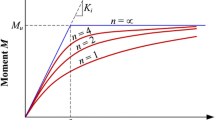Abstract
One of the most significant behavioral characteristics for bolted connections results in prying action and slip in that ultimate strength capacity as well as energy dissipation can be determined based on these mechanisms. The experimental programs considered herein were performed to isolate the heavy clip-angle component of bolted moment connections so that an economic parametric investigation on prying action and slip mechanism should be conducted. So, in this paper, the proposed prying and slip model are evaluated by comparing their predictions to the results of experimental component tests with respects to failure modes, ultimate clip-angle capacity, and slip resistance. Thus, the adequacy of both proposed models generally used for connection design is validated through the comparison.
Similar content being viewed by others
References and notes
J. Liu and A. Astaneh-Asl, Cyclic tests of simple connection including the effect of slabs, ASCE Journal of Structural Engineering, 126(1) (2000) 32–39.
R. T. Leon, Seismic performance of bolted and riveted connections. Background reports: metallugy, fracture mechanics, welding, moment connections, and frame system behavior. FEMA publication No.288 Federal Emergency Management Association (FEMA), Washington (DC), USA (1997).
S. A. Martin, Lessons from damage to steel buildings during the Northridge earthquake, Engineering Structures, 20 (1998) 261–270.
R. T. Leon, Analysis and design problems for PR composite frames subjected to seismic loads. Eng. Struct. 20 (1998) 364–371.
J. C. Awkar and E. M. Lui, Seismic analysis and response of multistory semirigid frames, Engineering Structures, 21(5) (1999) 425–442.
J. A. Swanson and R. T. Leon, Bolted steel connections: Tests on T-stub components. Journal of Structural Engineering, ASCE Journal of Structural Engineering, 126(1) (2000) 50–56.
J. A. Swanson and R. T. Leon, Stiffness modeling of bolted T-stub connection components, ASCE Journal of Structural Engineering, 127(15) (2000) 498–505.
J. W. Hu, Seismic performance evaluations and analyses for composite moment frames with smart SMA PR-CFT connections. Ph.D. Dissertation, Georgia Institute of Technology, Atlanta, GA, USA (2008).
T. Park, W. S. Hwang, R. T. Leon and J. W. Hu, Damage evaluation of composite-special moment frames with concrete-filled tube columns under strong seismic loads, KSCE Journal of Civil Engineering, 15(8) (2011) 1381–1394.
A. Azizinamini and J. B. Radziminiski, Damage evaluation of composite-special moment frames with concrete-filled tube columns under strong seismic loads, ASCE Journal of Structural Engineering,115(12) (1989) 2979–2999.
F. H. Wu and W. F. Chen, A design model for semi-rigid connections, Engineering Structures, 12(2) (1990) 88–97.
S. S Lee and T. S. Moon, Moment-rotation model of semirigid connections with angles, Engineering Structures, 24(2) (2002) 227–237.
L. Calado, Non-linear cyclic model of top and seat with web angle for steel beam-to-column connections, Engineering Structures, 25(9) (2003) 1189–1197.
A. Pirmoz, A. S. Khoei, E. Mohammadrezapour and A. S. Daryan, Moment-rotation behavior of bolted top-seat angle connections, Journal of Constructional Steel Research, doi:10.1016/j.jscr. 2008.08.011 (2008).
J. A. Swanson, Characterization of the strength, stiffness, and ductility behavior of T-stun connection. Ph.D. Dissertation, Georgia Institute of Technology, Atlanta, GA, USA (1999).
C. S. Schrauben, Behavior of full-scale bolted beam-tocolumn T-stub and clip angle connections under cyclic loading, Master’s Thesis, Georgia Institute of Technology, Atlanta, GA, USA (1999).
J. W. Hu, R. T. Leon, Analyses and evaluations for composite-moment frames with SMA PR-CFT connections, Nonlinear Dynamics, 65(4) DOI 10.1007/s11071-010-9903-3 (2011).
American Institute of Steel Construction (AISC), Manual of steel construction: Load and Resistance Factor Design (LRFD), 3rd edition, Chicago, IL, USA (2001).
G. L. Kulak, J. W. Fisher and J. H. A. Struik, Guide to design criteria for bolted and riveted joint, 2nd edition, Johns Wiley & Sons, UK (1987).
W. A. Thornton, Prying action — A general treatment, AISC Engineering Journal, 22(2) (1985).
T. Park, W. Hwang and J. W. Hu, Plastic continuum models for truss lattice materials with cubic symmetry, KSME Journal of Mechanical Science and Technology, 24(3) (2010) 657–669.
Author information
Authors and Affiliations
Corresponding author
Additional information
Recommended by Associate Editor Youngseog Lee
Jong Wan Hu received his MS degrees from (1) G.W.W. School of Mechanical Engineering and (2) School of Civil and Environmental Engineering, respectively, in Georgia Institute of Technology. He then received his Ph.D degree from School of Civil and Environmental Engineering, Georgia Institute of Technology. Dr. Hu has been Post-Doctorate Research Fellow at Structural, Mechanics, and Material Research Group in Georgia Institute of Technology. Dr. Hu also worked as an Associate Research Fellow at the Korea Institute of S&T Evaluation and Planning (KISTEP) and an Assistant Administrator at the National S&T Council (NSTC) for two years. He is currently an Assistant Professor in the University of Incheon. He has been active in the member of ASME and ASCE. His research interests are in the area of computational solid mechanics, composite materials, and plasticity modeling.
Myung-Hyun Noh is a Senior Researcher at the Energy Infrastructure Research Department, Steel Structure Research Division, Research Institute of Industrial Science & Technology (RIST) in Korea. His research field includes numerical structural dynamics of extreme loading infrastructures, inverse problem & optimization technology for condition assessment of infrastructures, etc.
Rights and permissions
About this article
Cite this article
Hu, J.W., Chun, SS. & Noh, MH. Mechanical prying and slip model for bolted clip-angle components. J Mech Sci Technol 27, 477–482 (2013). https://doi.org/10.1007/s12206-012-1262-1
Received:
Revised:
Accepted:
Published:
Issue Date:
DOI: https://doi.org/10.1007/s12206-012-1262-1




